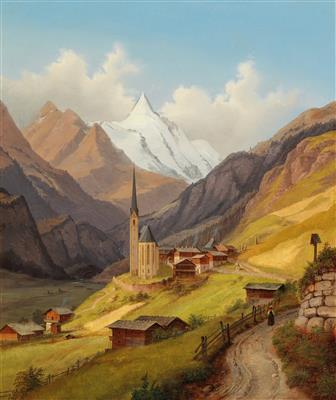Markus Pernhart

(Untermieger 1824–1871 St. Ruprecht near Klagenfurt)
Heiligenblut with a View of Grossglockner, c. 1860, oil on canvas 63.5 x 53 cm, framed
Compare:
Arnulf Rohsmann, Markus Pernhart. Die Aneignung von Landschaft und Geschichte, Klagenfurt 1992, p. 331 (Heiligenblut, 1856)
Markus Pernhart is undoubtedly one of the most important 19th century landscape painters in Austria. Thanks to his extensive oeuvre of paintings, he has also left behind historically valuable documents on Carinthia’s cultural and alpine landscape. His style combines a romantically naive depiction of nature indicative of early Biedermeier in the spirit of Franz Steinfeld, with the increasing demand for realistic, detailed reproduction. He explored the various regions of Carinthia like no other painter, defying adverse weather conditions and undertaking long, tiring journeys. The successful commission from his patron Max von Moro (1817 - 1899) to draw all Carinthian castles, as well as the demand for his picturesque, topographic views, focused his gaze onto the vistas that have become the embodiment of Carinthia’s landscape.
The most famous motif is probably the view of the scenic village of Heiligenblut in front of the Grossglockner massif. In the 19th century, the village was discovered by tourists and quickly became a very popular summer retreat for city dwellers as well as a sought-after visual motif for painters. Markus Pernhart, who climbed the Grossglockner about ten times and undoubtedly knew the place well, produced four different known versions including the present picture, in which he changed the point of view only slightly.
The solitary Gothic parish church standing on a small hill next to the village with its narrow, graceful architecture attracts the eye almost magnetically, eventually leading beyond its pointed tower to the majestic, white shining peak of the Grossglockner. However, Pernhart’s paintings are not photographic depictions - he also wants to convey the sublime nature of this view. Its tower and summit are even sharper and more dramatic, the farmhouses even smaller and more delicate, and the white of the glacier is even more dazzling due to the dark green of the forest and the rugged rock face. Pernhart shows us that Heiligenblut is a place where we all yearn to be, a place whose unique harmony of architecture and awe-inspiring nature he has timelessly preserved in this painting.
Esperta: Dr. Marianne Hussl-Hörmann
 Dr. Marianne Hussl-Hörmann
Dr. Marianne Hussl-Hörmann
+43-1-515 60-765
marianne.hussl-hoermann@dorotheum.at
09.11.2020 - 16:00
- Prezzo realizzato: **
-
EUR 57.800,-
- Stima:
-
EUR 25.000,- a EUR 35.000,-
Markus Pernhart
(Untermieger 1824–1871 St. Ruprecht near Klagenfurt)
Heiligenblut with a View of Grossglockner, c. 1860, oil on canvas 63.5 x 53 cm, framed
Compare:
Arnulf Rohsmann, Markus Pernhart. Die Aneignung von Landschaft und Geschichte, Klagenfurt 1992, p. 331 (Heiligenblut, 1856)
Markus Pernhart is undoubtedly one of the most important 19th century landscape painters in Austria. Thanks to his extensive oeuvre of paintings, he has also left behind historically valuable documents on Carinthia’s cultural and alpine landscape. His style combines a romantically naive depiction of nature indicative of early Biedermeier in the spirit of Franz Steinfeld, with the increasing demand for realistic, detailed reproduction. He explored the various regions of Carinthia like no other painter, defying adverse weather conditions and undertaking long, tiring journeys. The successful commission from his patron Max von Moro (1817 - 1899) to draw all Carinthian castles, as well as the demand for his picturesque, topographic views, focused his gaze onto the vistas that have become the embodiment of Carinthia’s landscape.
The most famous motif is probably the view of the scenic village of Heiligenblut in front of the Grossglockner massif. In the 19th century, the village was discovered by tourists and quickly became a very popular summer retreat for city dwellers as well as a sought-after visual motif for painters. Markus Pernhart, who climbed the Grossglockner about ten times and undoubtedly knew the place well, produced four different known versions including the present picture, in which he changed the point of view only slightly.
The solitary Gothic parish church standing on a small hill next to the village with its narrow, graceful architecture attracts the eye almost magnetically, eventually leading beyond its pointed tower to the majestic, white shining peak of the Grossglockner. However, Pernhart’s paintings are not photographic depictions - he also wants to convey the sublime nature of this view. Its tower and summit are even sharper and more dramatic, the farmhouses even smaller and more delicate, and the white of the glacier is even more dazzling due to the dark green of the forest and the rugged rock face. Pernhart shows us that Heiligenblut is a place where we all yearn to be, a place whose unique harmony of architecture and awe-inspiring nature he has timelessly preserved in this painting.
Esperta: Dr. Marianne Hussl-Hörmann
 Dr. Marianne Hussl-Hörmann
Dr. Marianne Hussl-Hörmann
+43-1-515 60-765
marianne.hussl-hoermann@dorotheum.at
|
Hotline dell'acquirente
lun-ven: 10.00 - 17.00
kundendienst@dorotheum.at +43 1 515 60 200 |
| Asta: | Dipinti dell’Ottocento |
| Tipo d'asta: | Asta in sala con Live Bidding |
| Data: | 09.11.2020 - 16:00 |
| Luogo dell'asta: | Wien | Palais Dorotheum |
| Esposizione: | 02.11. - 09.11.2020 |
** Prezzo d'acquisto comprensivo di tassa di vendita e IVA
Non è più possibile effettuare un ordine di acquisto su Internet. L'asta è in preparazione o è già stata eseguita.
